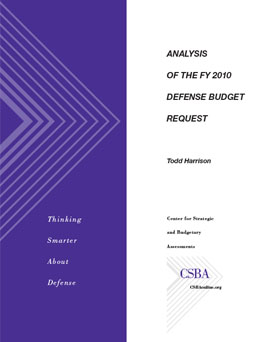
The Obama Administration has requested a total of $668 billion for the Department of Defense (DoD) in the FY 2010 budget. The “base” budget for the Department includes $534 billion in discretionary funding and an additional $4 billion in mandatory funding. The budget also includes, for the first time, full-year funding for the wars in Iraq and Afghanistan—now termed Overseas Contingency Operations (OCO). The cost of the wars is estimated at $130 billion for FY 2010. In real terms, the base DoD budget is an $18 billion increase over last year’s budget, while the funding for the wars in Iraq and Afghanistan is a $17 billion decrease from FY 2009.
From FY 2001 to FY 2009 the base defense budget grew at an average real rate of 4.4 percent annually. The FY 2010 budget request slows the real rate of growth to 3.4 percent and projects a future rate of growth in the base budget of just 0.2 percent per year. Total DoD spending grew by 73 percent in real terms from FY 2001 to FY 2009, much of which was due to the cost of the wars in Iraq and Afghanistan. The FY 2010 budget request proposes a 1 percent decrease in total DoD spending, due primarily to reductions in the war-related funding.
From an historical perspective, the Obama Administration’s defense budget remains near record levels. The previous peak in defense spending occurred in 1985 under the Reagan Administration. At $538 billion, the FY 2010 base defense budget, not including the added cost of the wars, exceeds the Reagan peak of $517 billion in 2010 dollars. Top-line projections for the base defense budget show that while defense spending will not continue to increase at the same rate as before, the Obama Administration intends to maintain a high level of funding in the coming years. The base defense budget proposed for the administration’s first four years (FY 2010 - FY 2013) puts the president on pace to spend more on defense, in real dollars, than any other president has in one term of office since World War II.
Highlights of the administrations's budget proposal:
- The 2010 budget request moves non-war related items previously funded through supplemental appropriations into the base defense budget. According to the Department, the amount of this transfer totals $13 billion. It includes the cost of increasing the end strength of the Army and Marine Corps, additional UAVs and ISR assets, and additional helicopter crews and support systems. This shift in funding is one reason the base defense budget is increasing this year and the cost of the wars is decreasing.
- In a break from the previous administration, the Obama Administration has laid out a projection for the cost of the wars in Iraq and Afghanistan over the coming years as part of the budget request. These projections reveal a significant decrease in funding for the wars, falling from $130 billion in FY 2010 to just $50 billion each year thereafter. This is consistent with the administration’s stated goal of pulling combat forces out of Iraq in FY 2011, and is somewhat in line with CBO estimates of future war costs. But further escalation of the war in Afghanistan or a change in the situation in Iraq would almost certainly require these estimates to be revised upward.
- In an unusual step, the Department’s budget does not include a detailed Future Year Defense Program (FYDP), although a top-line projection for future years is included. The Secretary of Defense has attributed the absence of the FYDP to the ongoing Quadrennial Defense Review (QDR), which will make determinations about future programs before the FY 2011 budget cycle.
- The budget request includes a special section entitled “Terminations, Reductions and Savings” that highlights $17 billion in program cuts or cancellations in the federal budget. Over half of these cuts, $8.8 billion, come from DoD programs—a relatively small portion (1.6 percent) of the defense budget. Moreover, while a number of defense programs were scaled back or terminated, many others were accelerated and received additional funding.
- Personnel costs are one of the fastest growing areas of the defense budget, growing at a real average annual rate of 5.6 percent since 2001. The growth in recent years is due in part to increases in the end strength and the rising costs of healthcare. Healthcare costs comprise $47 billion of the budget request and are projected to continue to increase by 5 to 7 percent annually. Outside of the DoD budget, the cost of veterans’ benefits (which includes additional healthcare expenses) is rising at an even higher rate. The administration is requesting $110 billion in funding for veterans, a real increase of 12 percent from FY 2009.
- The budget takes steps toward reform by including war costs as part of the budget request and beginning to rebalance acquisitions to focus more on irregular warfare and near-term threats. However, several issues remain that will need to be addressed in the future. Defense acquisitions are taking longer to procure systems in smaller quantities with lower performance than promised, at a higher price than anticipated. At the same time, military pay, healthcare, retirement, and other benefits are growing faster than the overall defense budget. If allowed to continue, personnel-related costs will begin to crowd out other parts of the budget, specifically procurement and RDT&E, and will hamper the Department’s ability to properly equip the force.



























